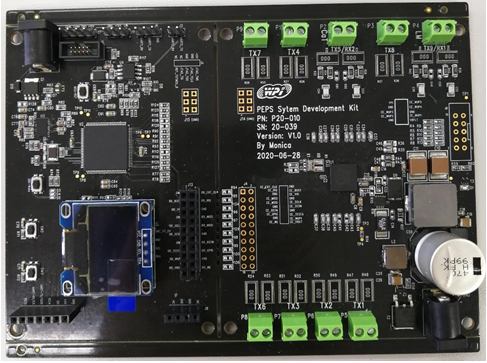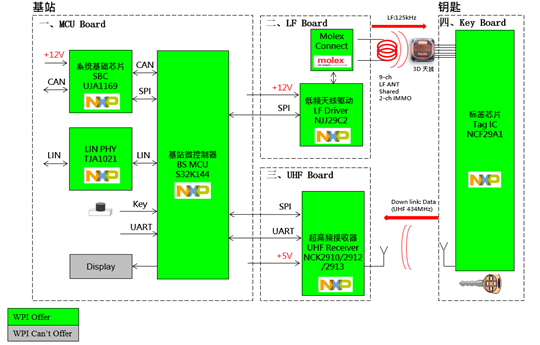
0755-83687076
Author: admin Time:2021-12-16 Click:
On December 14, 2021, WPG Holdings, a leading semiconductor component distributor committed to the Asia-Pacific market, announced that its subsidiary, World Peace, has launched an automotive keyless entry and start system solution based on NXP's S32K144, NJJ29C2, NCF29A1, and NCK2912 chips.

Figure 1 - Demonstration board diagram of the PEPS keyless entry and start system solution from WPG Holdings World Peace based on NXP products
With the iteration of various technologies, automotive applications are innovating at an unimaginable pace. Among them, the development of the Passive Entry Passive Start (PEPS) system has brought convenience and comfort to car owners while further enhancing vehicle security. The system consists of a controller, radio frequency (RF) transmitters, and receivers. When the key is within an effective range, the car owner pulls the door handle or presses the push-button start switch, and the corresponding module sends a terminal signal to awaken the main controller, initiating the entire communication process. During this process, it is not necessary to use a key to open the door or start the engine.
The PEPS system solution from WPG Holdings World Peace, based on NXP's S32K144 main control MCU, NJJ29C2 low-frequency driver, NCF29A1 chip, and NCK2912 ultra-high frequency receiver, offers customers an exceptional driving experience.

Figure 2 - Block diagram of the PEPS keyless entry and start system solution from WPG Holdings World Peace based on NXP products
The main control chip of this solution, S32K144, is an automotive-grade general-purpose MCU launched by NXP based on the ARM Cortex-M4F core. This product features a DSP instruction set and a single-precision floating-point unit (FPU), capable of running at a maximum frequency of 112MHz. It boasts extremely high computational capabilities, providing the equivalent computing power of a 150MHz PowerPC e200z4 core. Additionally, the S32K144 offers a rich array of peripheral interfaces and functional expandability.
In terms of low-frequency driving, the NJJ29C2 chip used in this solution is a base station chip suitable for keyless entry/start (PKE/PKG), featuring 5-9 built-in LF drivers with high activation capability. It also supports a wakeup input (WUP) function related to battery voltage. These functions are used to connect the door handle interface to the LF base station, ensuring short latency between the door handle and LF transmission.
Furthermore, the NCF29A1 chip is embedded in the smart key end of this solution. This chip, packaged in HVQVN32, combines the keyless system (PKE), remote RF transmitter, and immobilizer system into one, enabling new key designs and form factors in smartphones and smartwatches to support the enhancement of automotive access systems through mobile devices. On the vehicle end, the NCK2912 high-frequency receiver is employed to ensure real-time communication.

Figure 3 - Scenario application diagram of the PEPS keyless entry and start system solution from WPG Holdings World Peace based on NXP products
With the use of these high-performance devices, this solution can achieve functions such as car key ID storage, keyless entry (PKE), keyless start (PKG), automotive immobilization (IMMO), and remote keyless entry (RKE).
Core technological advantages:
- Integrated dual IMMO functionality, supporting up to 9 LF antennas;
- Can transmit encrypted high-frequency signals, with a maximum LF drive current of 2.5A;
- The NCF29A1 features excellent LF sensitivity and low power consumption at the microamp level;
- Can locate keys via RSSI, complying with the HT-3 encryption protocol;
- Supports RF frequency hopping communication.
Solution specifications:
- Implements complete IMMO/PKE/PKG/RKE functionality at the base station, displaying status on the screen;
- Displays RSSI values;
- Antenna diagnostics and impedance testing, displaying results, supports SWD interface;
- Key to base station PKE communication distance can reach 3-4m;
- Key to base station RKE communication distance can exceed 20m.